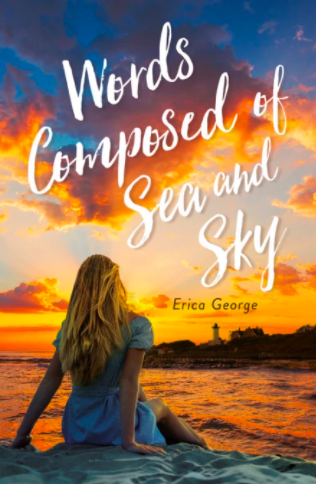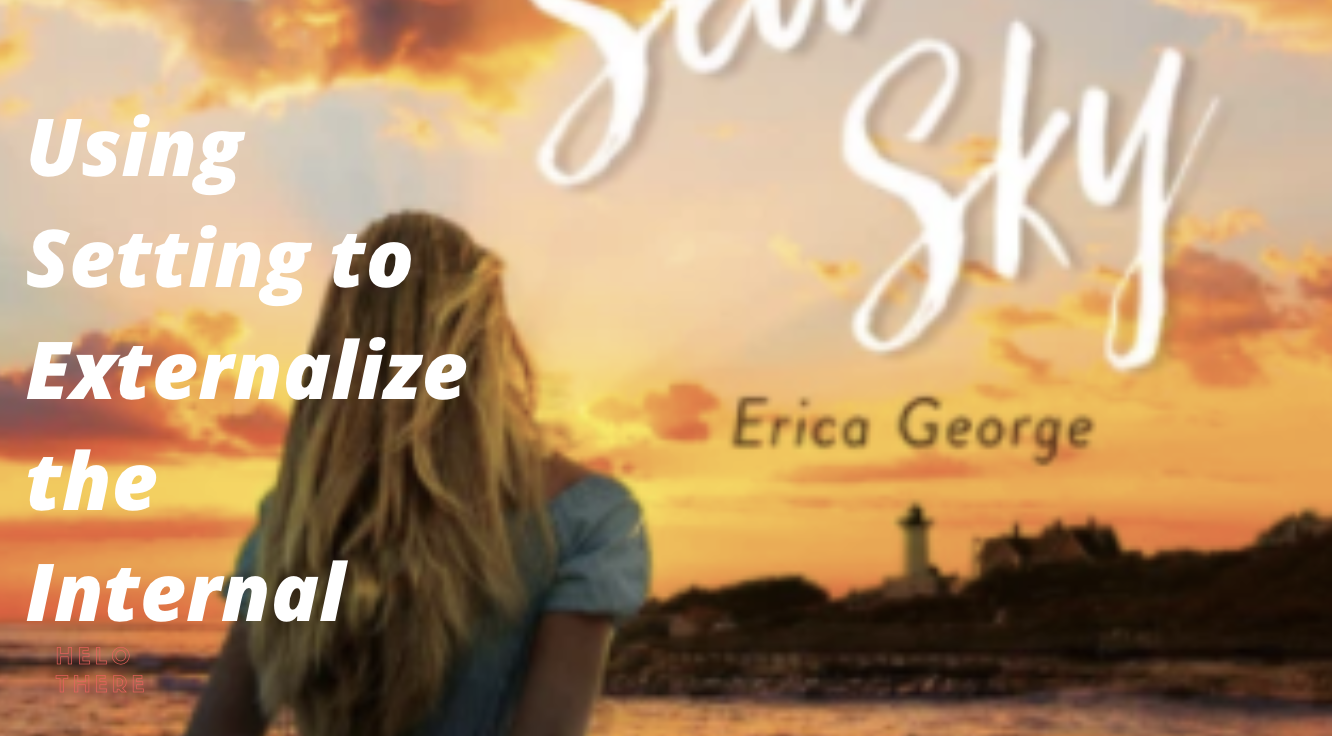craft review by Erin Nuttall

Quick, name a book that wouldn’t be the same without the setting. You might have come up with: The Witch of Blackbird Pond, Watership Down, Peter Pan, Alice in Wonderland, or The Mixed-Up Files of Mrs. Basil E. Frankwieler, Counting by 7s, The Tiger Rising, Wolf Hollow. These new and classic children’s books take place in locations that are as crucial to the stories as the characters themselves. Without these specific settings, they wouldn’t be the memorable, beloved stories that continue to engage readers.
In Erica George’s debut young adult novel, Words Composed of Sea and Sky, she uses the contradictory nature of the Cape Cod setting to highlight the inner conflicts of her two POV characters, Michaela (present) and Leta (1860s). Michaela and Leta are both teenage girls living in Cape Cod who use poetry to help them discover who they are and how to use their voices. While the characters don’t interact, they intersect through poetry, romance, and their shared setting.
Immersing a Reader in Place
The detailed descriptions of Cape Cod throughout both stories give the reader glimpses of the beauties and unique aspects of the setting which immerse the reader in place.
When I break through the branches, the beach heather of the cliffs stretches out before me, and beyond that, the sea, bright and blinding forever. (14)
I follow the cobblestone sidewalk past little restaurants, the white clapboard church on the hill, and its gated cemetery with jagged, tilting headstones that jut out from the rocky soil, so grimy with age that the names of the dead are difficult to read. The captains’ houses rise before me, most of them exquisitely restored and all of them immaculately maintained. It’s like walking back through time. (16)
Notice how George chooses words and phrases that are specific to her setting: heather of the cliffs; white clapboard church; jagged, tilting headstones; grimy with age; exquisitely restored and immaculately maintained. These descriptions are so vivid readers can easily picture where the characters are. They also serve as cues to help readers understand how place affects who the characters are as well as their actions.
Setting Mirrors Internal Conflict
George highlights the inner conflict of the two main characters by showing conflict within the setting. For instance, in an early scene, Michaela gets into an argument with her parents. She wants to attend an expensive poetry camp that she feels will open doors to a future for her as a poet. Her parents tell her that they don’t think they can afford it, but then readily agree to her little sister attending an expensive summer camp because it saves them the cost of child care. Michaela runs out of the house and to the sea where she is confronted with the opposing way this specific place, Cape Cod, and the sea interact.
Henry David Thoreau said that here, at the tip of Cape Cod, you can put all of America behind you. But I think he forgot that the best part of being here is knowing that the rest of the world is before you. That the sea can whisk you along wherever it decides to go. There’s something grounding in that. Something that keeps me still. Something that makes me stay here, at the tip of the world, the start of everything. The start of whatever I want. (15)
Michaela is facing the conflicting realities of becoming an adult: able to understand her parent’s reasoning while still feeling the injustice of it. The contradictory ideas of staying and going, of the world behind you and ahead of you, of escaping versus staying put are illustrated in the vicissitudes of the sea that George presents and underline Michaela’s feelings for the reader .
Setting Mirrors Emotion
Later, Michaela begins spending time with cute baseball player Finn. She has only ever seen him in one light and has firm ideas of who he is. She’s put him in a box. But as they spend time together she learns more about him and her old ideas of him war with the new ones. Together they visit the Maritime Museum located on a cliff near the lighthouse.
It’s like sensory deprivation and overload all at once. The rush of the wind and the roar of the waves drowns out any wayward thought I might have, and the sea is pale and gray, the late afternoon sun far behind us. (85)

Again George uses the setting as a mirror of what Michaela is feeling. She’s suddenly seeing Finn differently, and she is overwhelmed and exhilarated by it. Even if the reader has not had a similar experience, discovering new facets to a person they thought they knew, they can better imagine and be sympathetic to Michaela’s experience thanks to the descriptions of the sea.
George does the same type of emotional mirroring with her second POV character, Leta, a girl in the 1860s who, like Michaela, lives in Cape Cod and loves poetry and the sea. She has just spent time with her new love interest, Captain Benjamin Churchill, she’s on her way to visit her best friend, and all is finally right in her world.
The path to the lighthouse curves around and up the hill, and when I reach the top, I breathe in the sight: the Atlantic Ocean for as far as the eye can see. Nothing is on the horizon except a sloop, probably on its way to Boston, and endless possibilities (185).
George uses two pieces of setting to show the reader Leta’s feelings. The lighthouse is a beacon of hope and security. The sea is the opening of a new world with endless options. Both show how Leta is feeling about a new love, and a new life with someone who loves the sea and poetry as much as she does. His love lights a new world and new possibilities that she couldn’t previously imagine.
Rich Setting Enriches
Words Composed of Sea and Sky relies on the vivid descriptions of the setting that both ground the reader in reality and whisk them into the world of the story and the mind and hearts of its main characters. As writers, we can look to our settings to provide a wealth of tools to not only add depth to the story but to underline the experiences of the characters, their feelings, their motivations, their desires.
Now It’s YOUR Turn
If you’re looking to add more than ambiance through setting take a look at Words Composed of Sea and Sky, any of the books I listed, or a favorite of yours, and look for the ways that the setting mirrors, predicts, or underlines the emotions of the characters.
- Take notes. How do they do it?
- Make a list of how you can implement something similar in your WIP.
- Look for areas where your WIP is feeling flat or your characters are seeming a little underdeveloped. Could the setting be the answer? (I’ll go ahead and answer this: YES!)
- Pick a scene in your WIP. Identify the character’s emotion. Write a paragraph of setting that reflects that emotion. Consider how you can incorporate that setting into the scene.
Expanding how you use the setting can definitely improve your WIP and might just be the tool you’ve been looking for.
For more on SETTING, check out these KidLit Craft posts!
Erin Nuttall holds an MFA in Writing for Children and Young Adults from Vermont College of Fine Arts and is an active member of SCBWI and ALAN. She lives outside of Chicago with her family where she writes stories for middle grade and young adult readers that offer a humorous take on friendship, identity, feminism, and romance.


COMMENTs:
0